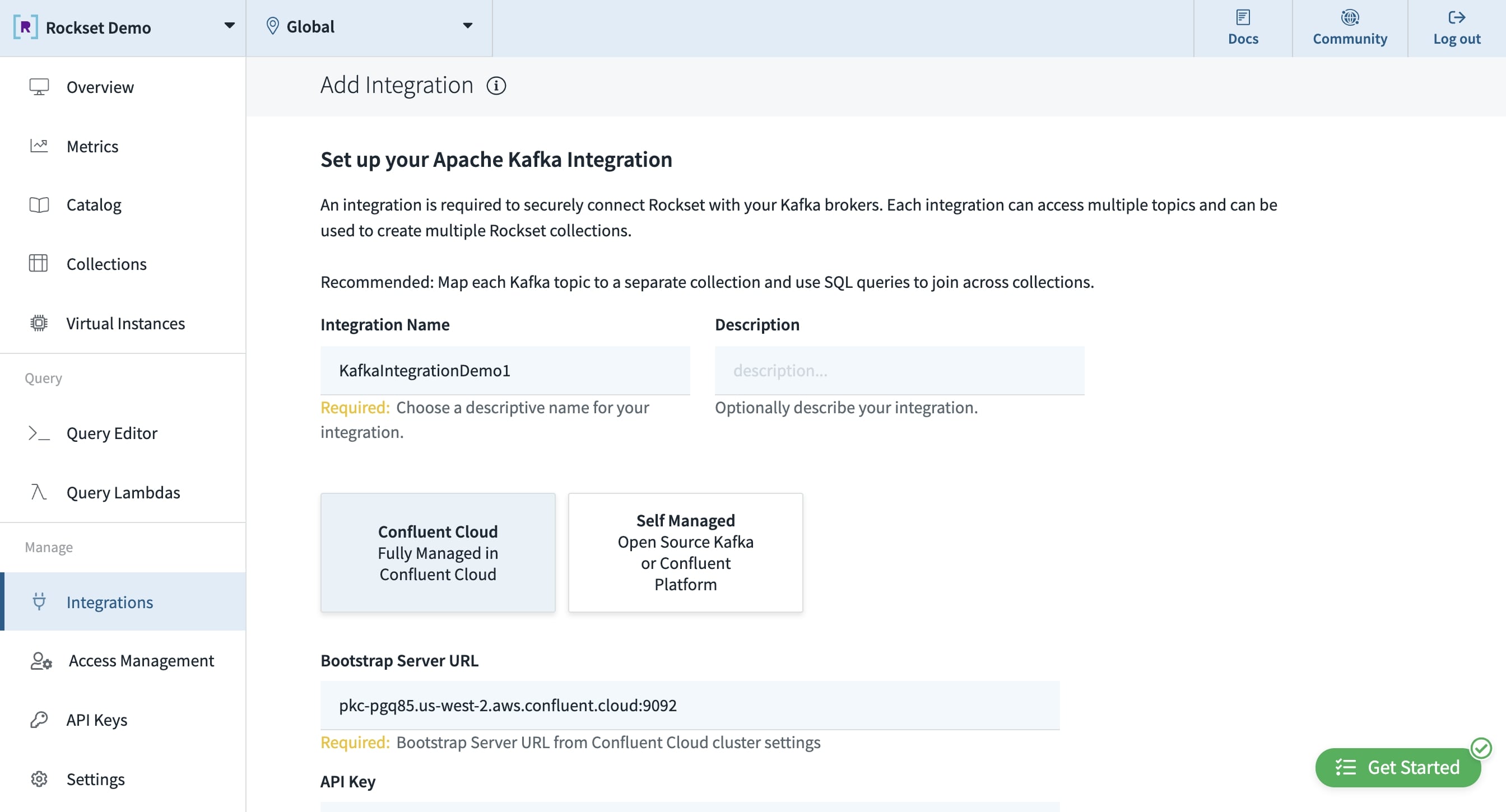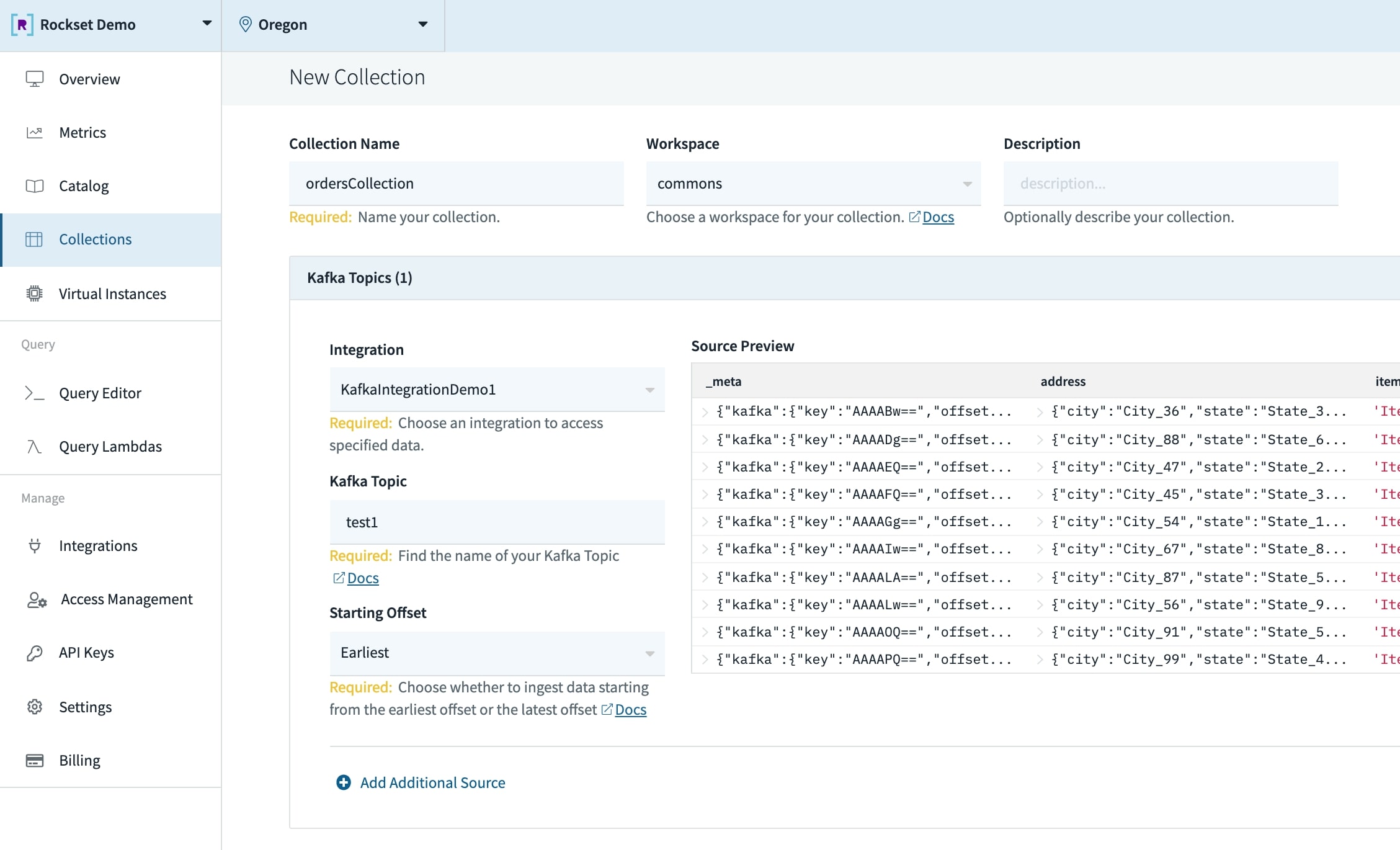[ad_1]
We’re introducing a brand new Rockset Integration for Apache Kafka that gives native assist for Confluent Cloud and Apache Kafka, making it less complicated and quicker to ingest streaming knowledge for real-time analytics. This new integration comes on the heels of a number of new product options that make Rockset extra inexpensive and accessible for real-time analytics together with SQL-based rollups and transformations.
With the Kafka Integration, customers now not have to construct, deploy or function any infrastructure part on the Kafka facet. Right here’s how Rockset is making it simpler to ingest occasion knowledge from Kafka with this new integration:
- It’s managed fully by Rockset and could be setup with only a few clicks, conserving with our philosophy on making real-time analytics accessible.
- The combination is steady so any new knowledge within the Kafka subject will get listed in Rockset, delivering an end-to-end knowledge latency of two seconds.
- The combination is pull-based, making certain that knowledge could be reliably ingested even within the face of bursty writes and require no tuning on the Kafka facet.
- There isn’t any have to pre-create a schema to run real-time analytics on occasion streams from Kafka. Rockset indexes all the knowledge stream so when new fields are added, they’re instantly uncovered and made queryable utilizing SQL.
- We’ve additionally enabled the ingest of historic and real-time streams in order that prospects can entry a 360 view of their knowledge, a typical real-time analytics use case.
On this weblog, we introduce how the Kafka Integration with native assist for Confluent Cloud and Apache Kafka works and stroll by find out how to run real-time analytics on occasion streams from Kafka.
A Fast Dip Beneath the Hood
The brand new Kafka Integration adopts the Kafka Client API , which is a low-level, vanilla Java library that could possibly be simply embedded into functions to tail knowledge from a Kafka subject in actual time.
There are two Kafka client modes:
- subscription mode, the place a bunch of customers collaborate in tailing a typical set of Kafka matters in a dynamic means, counting on Kafka brokers to supply rebalancing, checkpointing, failure restoration, and many others
- assign mode, the place every particular person client specifies assigned subject partitions and manages the progress checkpointing manually
Rockset adopts the assign mode as we’ve got already constructed a general-purpose tailer framework primarily based on the Aggregator Leaf Tailer Structure (ALT) to deal with the heavy-lifting, equivalent to progress checkpointing and customary failure circumstances. The consumption offsets are utterly managed by Rockset, with out saving any data inside consumer’s cluster. Every ingestion employee receives its personal subject partition project and final processed offsets in the course of the initialization from the ingestion coordinator, after which leverages the embedded client to fetch Kafka subject knowledge.

The above diagram exhibits how the Kafka client is embedded into the Rockset tailer framework. A buyer creates a brand new Kafka assortment by the API server endpoint and Rockset shops the gathering metadata contained in the admin server. Rockset’s ingester coordinator is notified of latest sources. When any new Kafka supply is noticed, the coordinator spawns an inexpensive variety of employee duties outfitted with Kafka customers to start out fetching knowledge from the shopper’s Kafka subject.
Kafka and Rockset for Actual-Time Analytics
As quickly as occasion knowledge lands in Kafka, Rockset mechanically indexes it for sub-second SQL queries. You possibly can search, mixture and be part of knowledge throughout Kafka matters and different knowledge sources together with knowledge in S3, MongoDB, DynamoDB, Postgres, and extra. Subsequent, merely flip the SQL question into an API to serve knowledge in your software.

A pattern structure for real-time analytics on streaming knowledge from Apache Kafka
Let’s stroll by a step-by-step instance of analyzing real-time order knowledge utilizing a mock dataset from Confluent Cloud’s datagen. On this instance, we’ll assume that you have already got a Kafka cluster and subject setup.
An Straightforward 5 Minutes to Get Setup
Setup the Kafka Integration
To setup Rockset’s Kafka Integration, first choose the Kafka supply from between Apache Kafka and Confluent Cloud. Enter the configuration data together with the Kafka supplied endpoint to attach and the API key/secret, for those who’re utilizing the Confluent platform. For the primary model of this launch, we’re solely supporting JSON knowledge (keep tuned for Avro!).

The Rockset console the place the Apache Kafka Integration is setup.
Create a Assortment
A group in Rockset is just like a desk within the SQL world. To create a group, merely add in particulars together with the title, description, integration and Kafka subject. The beginning offset lets you backfill historic knowledge in addition to seize the newest streams.

A Rockset assortment that’s pulling knowledge from Apache Kafka.
Rework and Rollup Information
You might have the choice at ingest time to additionally remodel and rollup occasion knowledge utilizing SQL to cut back the storage dimension in Rockset. Rockset rollups are capable of assist advanced SQL expressions and rollup knowledge accurately and precisely even for out of order knowledge.
On this instance, we’ll do a rollup to mixture the whole models offered (SUM(orderunits)) and whole orders made (COUNT(*)) in a specific metropolis.

A SQL primarily based rollup at ingest time within the Rockset console.
Question Occasion Information Utilizing SQL
As quickly as the info is ingested, Rockset will index the info in a Converged Index for quick analytics at scale. This implies you may question semi-structured, deeply nested knowledge utilizing SQL without having to do any knowledge preparation or efficiency tuning.
On this instance, we’ll write a SQL question to search out the town with the very best order quantity. We’ll additionally be part of the Kafka knowledge with a CSV in S3 of the town IDs and their corresponding names.

🙌 The SQL question on streaming knowledge returned in 91 Milliseconds!
We’ve been capable of go from uncooked occasion streams to a quick SQL question in 5 minutes 💥. We additionally recorded an end-to-end demonstration video so you may higher visualize this course of.
Embedded content material: https://youtu.be/jBGyyVs8UkY
Unlock Streaming Information for Actual-Time Analytics
We’re excited to proceed to make it straightforward for builders and knowledge groups to investigate streaming knowledge in actual time. If you happen to’ve wished to make the transfer from batch to real-time analytics, it’s simpler now than ever earlier than. And, you may make that transfer right now. Contact us to hitch the beta for the brand new Kafka Integration.
About Boyang Chen – Boyang is a employees software program engineer at Rockset and an Apache Kafka Committer. Previous to Rockset, Boyang spent two years at Confluent on numerous technical initiatives, together with Kafka Streams, exactly-once semantics, Apache ZooKeeper removing, and extra. He additionally co-authored the paper Consistency and Completeness: Rethinking Distributed Stream Processing in Apache Kafka . Boyang has additionally labored on the adverts infrastructure workforce at Pinterest to rebuild the entire budgeting and pacing pipeline. Boyang has his bachelors and masters levels in laptop science from the College of Illinois at Urbana-Champaign.
[ad_2]